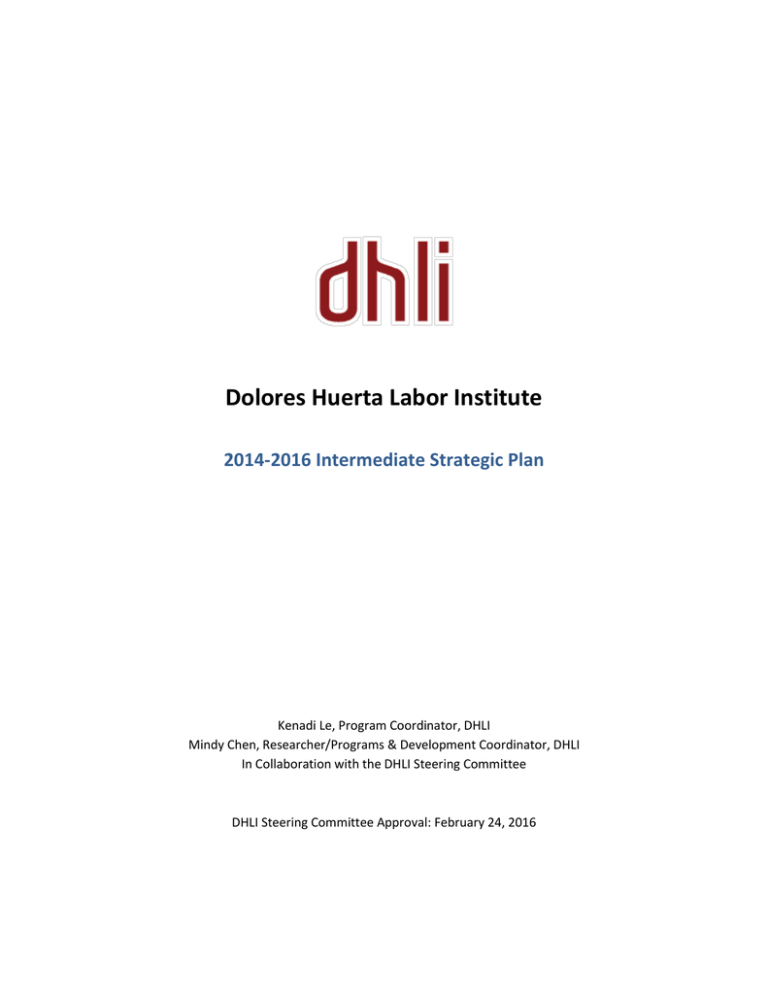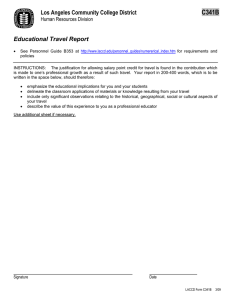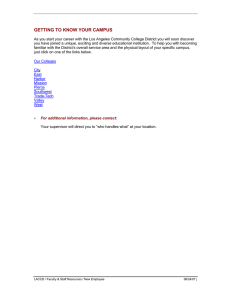Dolores Huerta Labor Institute 2014-2016 Intermediate Strategic Plan
advertisement

Dolores Huerta Labor Institute 2014-2016 Intermediate Strategic Plan Kenadi Le, Program Coordinator, DHLI Mindy Chen, Researcher/Programs & Development Coordinator, DHLI In Collaboration with the DHLI Steering Committee DHLI Steering Committee Approval: February 24, 2016 Table of Contents Introduction .......................................................................................................................... 3 Mission, Vision, and History................................................................................................... 4 Mission .......................................................................................................................................................................................... 4 Vision ............................................................................................................................................................................................. 4 The Birth of DHLI...................................................................................................................................................................... 4 What We Do ................................................................................................................................................................................ 4 Why DHLI?................................................................................................................................................................................... 4 Program Information ............................................................................................................. 6 Primary Services Provided ................................................................................................................................................... 6 Contribution to District Mission, Goals, and Outcomes ............................................................................................ 6 Main Clientele............................................................................................................................................................................. 6 Organizational Structure/Staffing ..................................................................................................................................... 6 Committee Membership ........................................................................................................ 7 Steering Committee Voting Members .............................................................................................................................. 7 Steering Committee Resource (Non-voting) Members............................................................................................. 7 Faculty Action Committee Voting Members .................................................................................................................. 7 Strategic Goals, Objectives, and Performance Measures ........................................................ 8 Strategic Goal #1 ....................................................................................................................................................................... 8 Strategic Goal #2 ....................................................................................................................................................................... 8 Strategic Goal #3 ....................................................................................................................................................................... 9 2 of 9 Introduction The 2014-2017 DHLI Intermediate Strategic Plan (ISP) updates DHLI’s 2011-2014 Strategic Plan (SP) by aligning it with the Los Angeles Community College District’s 2012-2017 Strategic Plan. The ISP aligns DHLI’s goals and planning cycle so it can better meet and support the goals of the 2012-2017 District Strategic Plan. While the goals of DHLI’s 2014-2017 ISP remain the same as those of the 2011-2014 SP, changes in the ISP reflect concerns that the 2011-2014 SP was too narrow in focus. Specifically, the structure of DHLI’s 2011-2014 SP resembled a detailed action plan rather than a comprehensive strategic plan, which left DHLI little flexibility to effectively leverage resources to address changes in client needs and demands. DHLI’s 2011-2014 SP focused on action steps to achieve DHLI’s strategic goals and was heavily centered on the Labor Students Educating Peers (L-StEP) initiative as the framework to reach those goals. L-StEP emphasized the role of faculty and their students on organizing educational labor events at their colleges. Due to the time commitment required, faculty interest in the initiative waned; DHLI phased out the L-StEP initiative in academic year 2012-2013 and has not conducted any L-StEP activities as of academic year 2014-2015. However, due to the structure of the SP, reallocating resources to other strategies to meet DHLI’s goals and mission would result in DHLI deviating from its SP. The 2014-2017 ISP thus takes a broader strategic approach to ensure that DHLI will meet its strategic goals and mission while having the flexibility to pursue long-term growth and respond to short-term changing priorities. Currently, as demand for DHLI resources continues, the updated ISP reflects DHLI’s ongoing commitment to achieve its mission by providing relevant educational resources that best support faculty who are interested in teaching about labor. The DHLI Steering Committee will review the ISP goals annually. 3 of 9 Mission, Vision, and History Mission The Dolores Huerta Labor Institute (DHLI) educates students about workers and unions in America. DHLI assists Los Angeles Community College District (LACCD) faculty in developing labor-themed courses, integrating labor themes across the curriculum, and developing other labor-themed activities. By expanding awareness of labor history and the impact of unions, DHLI promotes critical thinking, enhances career prospects and encourages civic participation among students. Vision To educate all LACCD students about the labor movement. The Birth of DHLI DHLI emerged amidst dramatic changes in the jobs and industries in the Los Angeles region. The LACCD and Los Angeles unions formed an educational partnership and established an institute to prepare students for this new economy. DHLI educates and engages students in their future as workers and professionals through classes, events, educational simulations, and other resources. What We Do Working people, unions and the labor movement play an important role in improving the lives of working individuals and families in Los Angeles County. DHLI is the first institute of its kind created to educate community college students about labor issues and history. We develop learning opportunities that allow many of the students attending the nine campuses of LACCD to learn about the political, social, and cultural impact of work, the public and private policies that govern employment, the practice of democracy in the workplace and society, and the significance of the labor movement. DHLI develops educational tools that inform and better prepare students for the workforce and social justice efforts. We do this by offering teaching resources for faculty, classes, special lectures, film series, workshops, seminars, and labor role-play simulations. With these educational resources, students will leave the LACCD colleges well-informed and better prepared for the workforce. Why DHLI? Most adults spend at least half their waking hours engaged in some form of work activity. During the last century, de-industrialization, deregulation, casualization, and information technology have radically altered the ways in which work is done. As a result, uneven opportunities emerged for different segments of the United States workforce. The numbers of men and women who work full-time year round yet remain below the poverty threshold increased significantly. These changes even negatively impact the quality of life of professionals and technical employees. As work is intimately related to other social, economic, and political issues, the inequality and instability on the job have widespread implications for 4 of 9 social justice and self-determination. In order to tackle the challenges of the workplace and beyond, community college students need the educational resources necessary to tackle the changing world of work. DHLI helps prepare students for these challenges. Our innovative program draws on the expertise of the directors of both of L.A.’s Labor Centers—John McDowell of Los Angeles Trade-Technical College (LATTC) and Kent Wong of UCLA, as well as Joanne Waddell, President of the Los Angeles College Faculty Guild, AFT Local 1521 and Don Gauthier, President of the LACCD District Academic Senate. 5 of 9 Program Information Primary Services Provided DHLI works with faculty to provide them resources to educate students about labor. We provide workshops, speakers, curriculum, and organize/provide other educational resources/activities. Contribution to District Mission, Goals, and Outcomes DHLI’s services align with the District’s mission in that we help faculty provide excellent education to prepare students to transfer and pursue civic engagement. DHLI contributes to District goals #2 and #4. We provide resources that help strengthen effective teaching and learning by providing a learnercentered educational environment. We also develop partnerships with the Labor Movement and community organizations to provide educational resources for LACCD faculty and students. Main Clientele: LACCD faculty and their students. Organizational Structure/Staffing: DHLI normally operates with two full-time consulting instructors. The program is a unit within the LACCD’s Office of Educational Programs and Institutional Effectiveness. DHLI reports to a Steering Committee (SC) that meets at least twice per year. The SC advises on program direction and issues. The SC’s membership consists of the presidents and representatives of the District Academic Senate, the AFT Faculty Guild, the AFT Staff Guild; the district administrator responsible for DHLI; the director and associate director of the LATTC Labor Center; the director of the UCLA Labor Center; and a labor liaison. DHLI also has a Faculty Action Committee (FAC) whose membership consists of at least one faculty member from each of the nine LACCD colleges. Membership is open to any interested faculty member. The FAC meets at least twice per year to plan activities. The DHLI consulting instructors serve as cochairs of the SC and FAC. 6 of 9 Committee Membership Steering Committee Members David Beaulieu. Representative, LACCD District Academic Senate Don Gauthier. President, LACCD District Academic Senate Joanne Waddell. President, Los Angeles Faculty Guild, AFT 1521 John McDowell. Director, LATTC Labor Center Kathleen Yasuda. Associate Director, LATTC Labor Center Kent Wong. Director, UCLA Labor Center Lou Siegel. Labor Liaison; Faculty, LATTC Labor Center Dr. Ryan Cornner. Vice Chancellor, LACCD Educational Programs and Services and Institutional Effectiveness Velma Butler. President, AFT College Staff Guild, AFT 1521A Faculty Action Committee Members Membership to the Faculty Action Committee is open to all interested faculty. The following table is a representative list of members. This list is not exhaustive. City: Glen Britton Joe Meyer Mission: John Morales Jose Maldonado East: Eileen Ie Michael Colling Natalina Monteiro Pierce: Chuck O’Connell Denise Munro Robb James McKeever Shigueru Tsuha Harbor: Bill Loiterman Ellen Joiner Jose Lopez Mona Dallas Reddick Southwest: Daniel Ortega Darren Cifarelli Kristine Wright Maisha Jones Valley: Laura Scott Pat Allen Scott Weigand Zack Knorr Trade-Tech: Ghosha Maffei Lou Siegel West Grace Chee Olga Shewfelt 7 of 9 Strategic Goals, Objectives, and Performance Measures Goal 1: To assist faculty by providing educational resources and helping integrate Labor Education into the curricula and activities of the nine (9) colleges of the Los Angeles Community College District. (Supports District Goal 2) Goal 2: To create and sustain a community of labor educators within the Los Angeles Community College District to support the Dolores Huerta Labor Institute’s mission. (Supports District Goals 2 and 4) Goal 3: To develop strategic partnerships with Los Angeles communities and the Labor Movement to secure resources to enhance Labor Education across the Los Angeles Community College District. (Supports District Goal 4) Strategic Goal #1 To assist faculty by providing educational resources and helping integrate Labor Education into the curricula and activities of the nine (9) colleges of the Los Angeles Community College District. Objective 1: Provide faculty with relevant labor educational resources to support labor education, the development of labor-focused courses, and the contextualization of existing courses with labor themes. Measure 1.1: Measure of client satisfaction with DHLI’s services/resources (from client survey). Objective 2: Increase the number of faculty served across all nine LACCD colleges. Measure 2.1: Number of faculty served. Objective 3: Improve the quality of resources provided. Measure 3.1: Measure of client review of DHLI’s resources (from client survey). Strategic Goal #2 To create and sustain a community of labor educators within the Los Angeles Community College District to support the Dolores Huerta Labor Institute’s mission. Objective 1: Communicate effectively and regularly with DHLI’s clients through emails, meetings, newsletters, and other methods as appropriate. Measure 1.1: Measure of client satisfaction with DHLI’s communications (from client survey). Measure 1.2: Effectiveness of DHLI communications (from client survey) Objective 2: Improve DHLI committee governance Measure 2.1: Number of committee meetings held and reports. Measure 2.2: Committee effectiveness (Committee self-evaluation) 8 of 9 Objective 3: Increase awareness, knowledge, and support for DHLI. Measure 3.1: Survey questions on client awareness, knowledge, and support for DHLI (from client survey) Strategic Goal #3 To develop strategic partnerships with Los Angeles communities and the Labor Movement to secure resources to enhance Labor Studies across the Los Angeles Community College District. Objective 1: Increase partnerships with labor and community organizations to support faculty and enhance the student learning experience. Measure 1.1: Number and type of labor and community organization partnerships. 9 of 9



